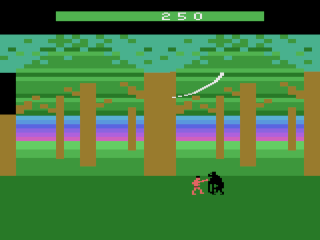|
|
Tarzan
|
Name:
|
Tarzan |
 |
| Company: | Coleco | |
|
Model #:
|
2662 | |
|
Programmers:
|
James Wickstead Design Associates Lawrence Schick & Phil Taterczynski (Game Design), Henry Will IV (Programmer), Todd Marshall (Sound), Robin McDaniel Ballweg (Graphics), Sylvia Day & Roger Booth (Additional Programming) |
|
| Year: | 1984 | |
|
Released?
|
No |
|
|
Notes:
|
A prototype manual
exists |
Tarzan (real name John Clayton II) is a character created by
Edgar Rice Burroughs in 1912. Tarzan was the
Viscount of Greystoke (a type of noble) who was orphaned in
Africa when his parents died on an expedition. The infant
Tarzan was then adopted and raised by a tribe of friendly great
apes resulting in him becoming a feral man living in the
jungle. Eventually Tarzan meets an American named Jane
whom he saves and marries. After briefly returning to
England he decides that his place is in the jungle among his ape
friends so he and Jane return to Africa. Tarzan has been
the subject of numerous novels (24 and counting), movies, and
even a few video games. In fact the original version of
Jungle Hunt (then known as Jungle King) featured Tarzan, just
not by name. The estate of Edgar Rice Burroughs sued Taito
and they were forced to change the character to an
explorer. Coleco managed to secure the rights to Tarzan as
a tie in for the 1984 movie Greystoke: The Legend of Tarzan and
created games for the Atari 2600, Atari 8-Bit computers, and
Colecovision. Of these only the Colecovision version was
actually released.
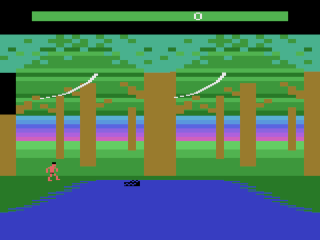

Tarzan is an action game in which you control the the titular Tarzan who must free his captured ape family from the evil hunters and Beastmen who are holding them captive in cages scattered throughout the jungle. Being a wild ape-man, Tarzan's only weapons are his spectacular climbing/leaping/swimming skills and punching. Tarzan must traverse several different types of screens in order to rescue all the apes and win the game. The sheer variety of screens in Tarzan is one of the reasons it required more memory than the average 2600 game.
As Tarzan moves through the jungle, he will face numerous enemies. These enemies can be stunned either punching them (The Great White Hunter, Bolgani the Gorilla King, and Beastmen) or jumping on them (Histah the Snake). Some enemies are invincible and must simply be avoided such as Gimla the Crocodile. Tarzan must also face the greatest enemy of all; Time. Tarzan is on a tight time table and must free all his captured friends before the timer bar at the top of the screen runs out or it's game over. Each time Tarzan is hit by an enemy, falls into the water, or falls to the ground he will be stunned for a few seconds (as dictated by the estate of Edgar Rice Burroughs, Tarzan can never actually die). During this stunned time, the timer counts down three times as fast, so be careful. The timer bar has three different colored sections (green, yellow, and red) that let you know how close you are to time running out.
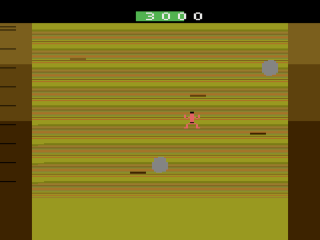
Tarzan is divided into several different areas/screens. Each screen has different gameplay elements and enemies.
The Jungle
Tarzan starts out the game in a random area the
jungle. Not only is the jungle alive, but everything in
this jungle is trying its best to kill Tarzan! Your goal
is to make your way to the right side of each screen either by
running/swimming across the ground, or by climbing trees and
swinging through the air by vines. The treetops are safer,
but require more skill as Tarzan must master the art of vine
travel. Unlike in Jungle Hunt, Tarzan cannot jump from
vine to vine, instead he must grab the large tree in the center
of the screen before proceeding to the next vine (press up while
Tarzan is flying over it). Keep in mind that not all
screens have vines and some may only have one, so you'll have to
scamper across the ground eventually. Missing a vine or
otherwise dropping to the ground from anything higher than a the
height of Tarzan himself will stun you and cost precious
time. Tarzan can also move to one of three different
'planes' on the jungle floor (close to the background, middle of
the screen, and closer to the bottom) by pressing up and down on
the joystick. Unlike the Colecovision and Atari 8-Bit
versions however Tarzan doesn't run to each plane, instead he
instantly pops into the new plane which can take a little
getting used to (this actually makes the game easier as there is
no delay in switching planes). By moving around the
different planes Tarzan can either line himself up with enemies
to attack them or, as is most likely the case, jump to a
different plane to avoid them.

On the ground Tarzan will face enemies in the form of Bolgani the ape, Histah the snake (who appears as a pair of eyes in the background until he jumps out as you pass), and Gimla the crocodile (who only appears in the water). Remember that Tarzan must punch Bolgani (stop moving and press the fire button), jump on Histah (press the fire button while moving), and avoid Gimla all together. After every major section of the game Tarzan will pass through the jungle area again, so it would pay to spend some time here learning the ropes (err... vines).
Eventually after passing through a few screens Tarzan
will come upon the hunters camp.
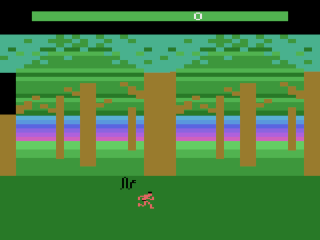
The Hunters Camp
In the hunters camp Tarzan will see a pole with a caged ape on top. Here Tarzan must avoid the crazed hunter attempting to shoot him, climb the center pole, and push the cage with the ape open. Once freed the ape will run off, Tarzan will gain some time back, and you'll be free to move onto the next segment of jungle. Remember Tarzan cannot leave a screen with a captive ape until the ape is freed.
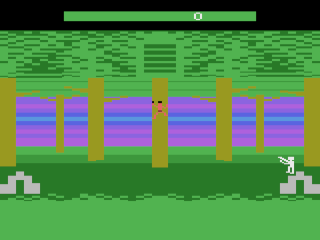
The Hanging Cages
After a few more jungle screens Tarzan will arrive at a
screen with two cages hanging above the jungle. These
cages are guarded by vicious Beastmen who walk on top of the
cages. Tarzan must climb up the trees on either side of
the screen, swing over to a cage via the vine, and punch it
open. If a Beastman hits Tarzan he will drop to the ground
below and be stunned for a time. Remember that Tarzan can
punch the Beastmen out to make them disappear. Once both
apes are freed Tarzan can move onto the next section.

The Cliffs of Opar
A few more jungle screens later and Tarzan will be at the deadly Cliffs of Opar. Here Tarzan must scale the steep cliff side while deadly boulders rain down on him from above. To avoid being squashed by the boulders Tarzan must hide out under the various ledges until the boulder has passed (these look like brown bars). Tarzan can also jump from side to side to quickly dodge out of the way of a boulder but he will be moved down the cliff a little after he lands so use this move sparingly. The best approach seems to be to quickly move in a diagonal direction rather than straight up so Tarzan has a chance to avoid the boulders without having to waste time under cliffs. After climbing up several screens of never ending boulders, Tarzan will finally reach the the top. Here Tarzan must run through a few more jungle screens before he makes it to the temple.
The cliffs screen is unique to the 2600 version of the
game and does not appear in the Colecovision or Atari 8-Bit
versions.

The Temple of Opar
Tarzan has finally made it to the lost Temple of Opar
where the Beastmen are holding the remaining apes. Here
Tarzan must open the cages on each floor of the temple while
punching out Beastmen. Once Tarzan has freed all the apes
on a level he can climb up to the next level of the temple using
the convenient stairs or ladders. After Tarzan has freed
all the apes he must swing off the top of the temple from the
waiting vine. The vine is unique to the Atari 2600 version
and is a replacement for the idol head that Tarzan had to
destroy in the Colecovision and Atari 8-Bit versions.
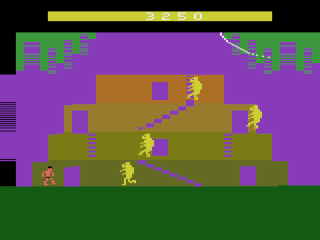
Down the Cliffs
Tarzan isn't done yet! After escaping the temple and running through yet more jungle, Tarzan will discover that the Beastmen are trying to lower the remaining captive apes down the side of the cliff (seriously, why do they want these apes so badly?). On this screen Tarzan must jump off the side of the cliff onto each cage and free the captive ape inside (there are no boulders this time thankfully). The Beastmen will try to shake Tarzan off of the cage so be careful. Once Tarzan frees all the apes his work is finally done and he can take a well deserved rest (until the next level starts that is).
Much like the first cliff screen, this one is unique to
the 2600 version of the game and does not appear in the
Colecovision or Atari 8-Bit versions.

One thing that cannot be stressed enough is how amazing the music is in Tarzan. From the driving beat on the jungle screens, to the tension building jingle on the cliff and temple screens, every single piece of music in the game seems to set the mood perfectly. The graphics are also a standout with Tarzan being well represented in his trademark loincloth and every screen having a bright exotic look to it. All the enemies in the game are single colored sprites due to the limitations of the 2600, but everyone from Gimla to Bolgani is recognizable and well animated (a rarity for a 2600 game). If there's one fault with the game it's the unbalanced difficulty. Even on the easiest difficulty some of the enemies on the jungle screens are relentless. Gimla will happily chomp poor Tarzan over and over after he fails to catch the vine while Histah will pursue you without mercy. Thankfully the Hunter, Bolgani, and Beastmen seem a little more sedate so Tarzan can catch a tiny break. Although the difficulty switches aren't used, the Select switch can be used to pause the game (this is because game variations are selected with the joystick not the Select switch). When the game is paused the screen will display a trippy visual of flashing colored lines until the player moves the joystick again.

It was well known that Tarzan had been completed and might exist somewhere, but the first copy didn't surface until early 2023 in an Ebay auction. Unfortunately the auction was long over before people began to take notice and no pictures of the prototype were preserved. However in early 2024 a second copy of the game surfaced complete with a production looking label. It was at this time that it was made known that the first prototype (which turned out to be board only) had been bought and the EPROM dumped. Both prototypes appear to be the final version of the game (Rev 22).

So why wasn't Tarzan released? The great gaming crash. Around the time Tarzan was completed (late April of 84) many game companies were going under and retailers were returning unsold games in droves. Coleco decided to drop out of the 2600 business around this time to concentrate on the Colecovision and newly launched ADAM (Roc n' Rope would be their last game released in June of that year). It was long thought that Tarzan was to use the special RAM/ROM chip that Pink Panther utilized and that the cost of this chip was what stopped its release. However Tarzan appears not to use this special chip and uses a regular board (albeit with special bankswitching) so it appears that this rumor can finally be put to rest.
Although Tarzan may not have seen the light of day back in 1984, thanks to the efforts of Video Game History Foundation the world can finally enjoy this gem 40 years later.
| Version | Cart Text | Description |
| 4/30/84 |
Tarzan Atari Rev 22 |
Final version |

